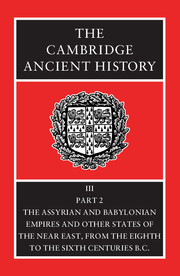Book contents
- Frontmatter
- Contents
- List of maps
- List of text-figures
- Preface
- PART I ASSYRIA AND BABYLONIA
- 21 Babylonia in the shadow of Assyria (747–626 B.C.)
- 22 Assyria: Tiglath-Pileser III to Sargon II (744–705 B.C.)
- 23 Assyria: Sennacherib and Esarhaddon (704–669 B.C.)
- 24 Assyria 668-635 B.C.: the reign of Ashurbanipal
- 25 The fall of Assyria (635–609 B.C.)
- 26 Assyrian civilization
- 27 Babylonia 605–539 B.C.
- 28 The culture of Babylonia
- 28a Neo-Babylonian society and economy
- 28b Babylonian mathematics, astrology, and astronomy
- 28c First-millennium Babylonian literature
- PART II THE EASTERN MEDITERRANEAN AND THE BLACK SEA
- Chronological Table
- Note on The Calendar
- BIBLIOGRAPHY
- Index
- Map 11: Phoenician and Punic sites in Spain
- Map 13: Scythia
- Map 14: Thrace
- References
28a - Neo-Babylonian society and economy
from 28 - The culture of Babylonia
Published online by Cambridge University Press: 28 March 2008
- Frontmatter
- Contents
- List of maps
- List of text-figures
- Preface
- PART I ASSYRIA AND BABYLONIA
- 21 Babylonia in the shadow of Assyria (747–626 B.C.)
- 22 Assyria: Tiglath-Pileser III to Sargon II (744–705 B.C.)
- 23 Assyria: Sennacherib and Esarhaddon (704–669 B.C.)
- 24 Assyria 668-635 B.C.: the reign of Ashurbanipal
- 25 The fall of Assyria (635–609 B.C.)
- 26 Assyrian civilization
- 27 Babylonia 605–539 B.C.
- 28 The culture of Babylonia
- 28a Neo-Babylonian society and economy
- 28b Babylonian mathematics, astrology, and astronomy
- 28c First-millennium Babylonian literature
- PART II THE EASTERN MEDITERRANEAN AND THE BLACK SEA
- Chronological Table
- Note on The Calendar
- BIBLIOGRAPHY
- Index
- Map 11: Phoenician and Punic sites in Spain
- Map 13: Scythia
- Map 14: Thrace
- References
Summary
With the establishment of the Neo-Babylonian kingdom there starts a rich flow of documentary sources. The period of less than ninety years between the reign of Nabopolassar and the occupation of Mesopotamia by the Persians is documented by tens of thousands of texts concerning household and administrative economy and private law, over ten thousand of which have been published so far. Their content is varied: promissory notes, contracts for the sale, lease or gift of land, houses or other property, for the hiring of slaves and freemen, documents connected with international and internal trade, records of lawsuits, correspondence concerning official business, letters with family news, and so on. All these texts come from temple and private archives. We have no state archives of Neo-Babylonian times at our disposal apart from a few stray texts. The rich material in the Neo-Babylonian sources has unfortunately still been insufficiently investigated. It is therefore impossible as yet to give a complete description of Neo-Babylonian society.
THE SOCIAL STRUCTURE OF NEO-BABYLONIAN SOCIETY
At the time when the Neo-Babylonian state came into being the inhabitants of some large Babylonian cities enjoyed special privileges. Only the fear of losing their civic privileges can explain why citizens of some cities (such as Nippur) remained faithful, in spite of great suffering and privation, to the Assyrian rulers under whom they had won these privileges, and fought the armies of Nabopolassar, the founder of the Neo-Babylonian kingdom. As we have seen, the citizens of Babylonian cities were exempt from military conscription and corvée.
- Type
- Chapter
- Information
- The Cambridge Ancient History , pp. 252 - 275Publisher: Cambridge University PressPrint publication year: 1992

